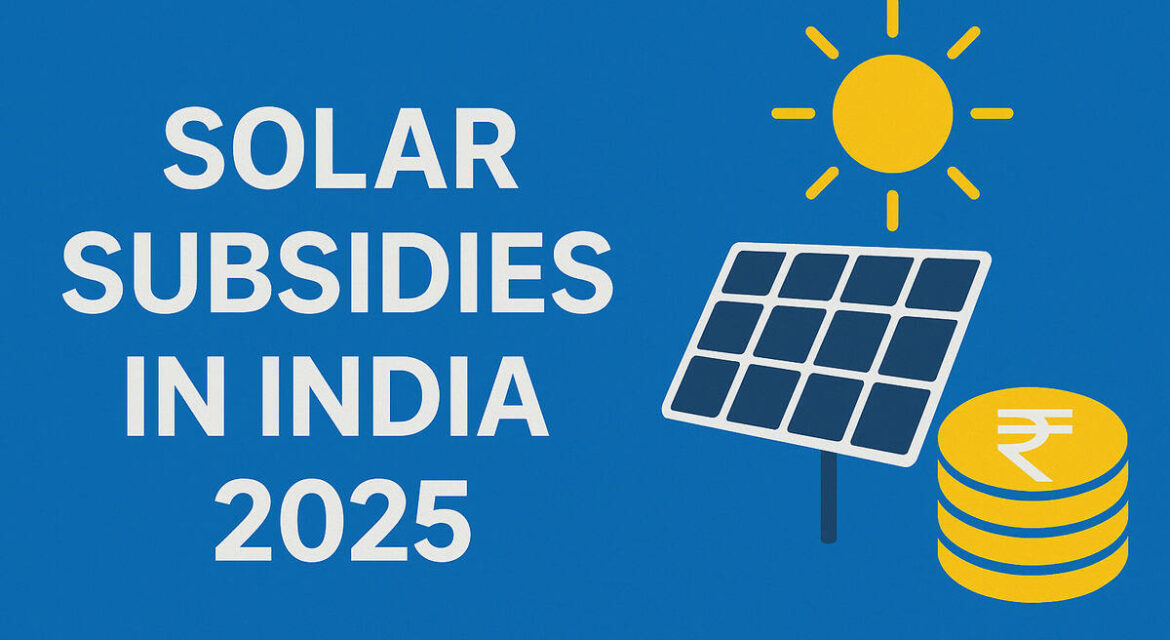As India accelerates its transition to renewable energy, solar power has become a cornerstone of this movement. To encourage widespread adoption, both the central and state governments offer various subsidies and incentives for residential solar installations. This comprehensive guide outlines the available subsidies in 2025 and provides a step-by-step process to claim them.
Central Government Subsidy: PM Surya Ghar Muft Bijli Yojana
Launched in February 2024, the Pradhan Mantri Surya Ghar Muft Bijli Yojana aims to empower 1 crore households by providing up to 300 units of free electricity monthly through rooftop solar installations. The scheme offers substantial subsidies to reduce the initial investment for homeowners.
Subsidy Structure:
- Up to 2 kW systems: ₹18,000 per kW (Total: ₹36,000)
- 2–3 kW systems: ₹18,000 per kW for the first 2 kW, plus ₹9,000 per kW for the additional capacity (Total: ₹45,000)
- Above 3 kW systems: ₹1,17,000 fixed subsidy
Note: Special category states receive an additional 10% subsidy per kW. PMSuryaGhar
Eligibility Criteria:
- Must be an Indian citizen.
- Own a residential property with suitable rooftop space.
- Have a valid electricity connection.
- Should not have previously availed any solar panel subsidy from the government.
State-Wise Solar Subsidies in 2025
In addition to central subsidies, several states offer their own incentives to promote solar energy adoption.
Uttar Pradesh (UP):
- Additional Subsidy: Up to ₹15,000 per kW, capped at ₹30,000 for rooftop installations.
- Application Process: Through the MNRE portal or the state’s KUSUM portal.
Maharashtra:
- Subsidy: Aligned with central schemes; specific post-subsidy costs detailed for various system capacities.
- Net Metering: Available.
Gujarat:
- Subsidy: 40% for systems up to 3 kW; 20% for larger installations.
- Additional Benefits: Net metering policy in place.
Delhi:
- Subsidy: Capital subsidy over and above MNRE’s 40%.
- Financial Assistance: Up to 60% subsidy plus 30% loan assistance.
Madhya Pradesh:
- Combined Subsidy: Central and state incentives can cover up to 40% of installation expenses.
For current details, check with your local DISCOM or state energy agency. You can also read more on solar service and maintenance to keep your system in top shape.
How to Claim Your Solar Subsidy
Claiming your solar subsidy involves a series of steps to ensure eligibility and proper installation.
Step 1: Register on the National Portal
- Visit the National Rooftop Solar Portal.
- Provide necessary details: State, Electricity Distribution Company (DISCOM), Consumer Number, Mobile Number, and Email.
Step 2: Submit Required Documents
- Identification Proof (Aadhar Card, PAN Card).
- Electricity Bill.
- Property Ownership Proof.
- KYC Documents.
Step 3: Choose an MNRE-Approved Vendor
- Select a vendor from the list of MNRE-approved installers.
- Ensure the vendor assists with the application and installation process.
Step 4: Installation and Inspection
- The selected vendor installs the solar system.
- Post-installation, the DISCOM conducts an inspection to verify the setup.
Step 5: Subsidy Disbursement
- Upon successful inspection, the subsidy amount is directly transferred to your bank account within 30 days.
Final Thoughts
Thanks to these subsidies, going solar has never been easier. You’ll save money on electricity and help the environment, all while increasing your home’s value.
Want to understand solar installation costs in India? Or how to choose the right solar provider? We’ve got you covered!
Also, see solar vs conventional power and solar panel and inverter lifespan to plan your investment better.
And if you want your system to last longer and save more, check out these maintenance tips.
Ready to Go Solar?
Call us at +91-99100 52488 or
Contact us for a free consultation—we’re here to help you every step of the way.






